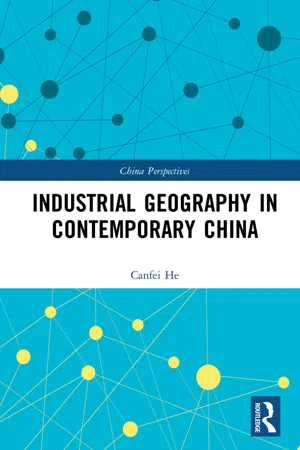1.1 Introduction
China’s industrial development has made profound achievements since 1949. Nowadays, China has 41 major industrial sectors and 525 sub-sectors, making it the only country in the world to host all the industrial categories listed in the United Nations Industrial Classification. The production capacity of China’s industry has been greatly improved, and its international competitiveness has been continuously enhanced. More importantly, China’s industry has also witnessed the development of technologies and improvement in innovation capabilities (Tang et al., 2019). From 1990 to 2010, China’s manufacturing value added (VA) accounted for 19.8% of the world, rising from 2.7%, and ranking first in the world. Moreover, China’s production capability of 221 kinds of industrial products reached the top in the world (Li, 2019). Therefore, China’s image as the world factory is well deserved. However, there are still many problems in China’s industrial development, such as uneven regional development and low industrial production efficiency.
Studies have reviewed the process of China’s industrialization from multiple perspectives including the characteristics, the achievements, the strategies, and so on (Shi & Li, 2019; Guan, 2019; Tao et al., 2019). Industrial geography pays more attention to the spatial variations in China’s industrial development. China’s reform and opening-up can be conceptualized as the triple processes of marketization, globalization, and decentralization, which have collectively reshaped China’s industrial geography (He & Hu, 2019; Hu, 2019). This chapter will discuss the process, strategy, structure, spatial distribution, and driving forces of industrialization in China, and further will focus on some new topics such as sustainability and innovation.
This chapter consists of the following parts. Section 1.2 reviews the history of China’s industrialization process and then introduces the main characteristics in different phases. Section 1.3 evaluates the implementation of industrial strategies in different periods. Next, Section 1.4 analyzes the structure of China’s industry. After that, Section 1.5 presents the spatial layout of China’s industrial development, aiming at dissecting the driving forces of industrial development (in Section 1.6). Section 1.7 focuses on the image of China as the world factory, and then presents the documents and data related to some typical achievements of China’s industrial development. Section 1.8 proposes the importance of sustainable development, and finally, Section 1.9 draws a conclusion.
1.2 Process of Industrialization in China
The 70-year development history of China’s industry can be divided into two periods based on the economic reform and opening-up in 1978. Before 1978, state-owned enterprises (SOEs) dominated industrial development in China, leading to the exaggerated development of resource-intensive heavy industry. Although considerable achievements were made at that time, especially the establishment of a relatively complete industrial system, this period also had the disadvantages of low efficiency and waste of resources. More seriously, the underestimation of the development of light industry led to a shortage economy and caused long-term failure at improving people’s living standards. Hence, after 1978, the country promoted the balanced development of heavy industry and light industry, recognized the importance of globalization and marketization, and launched an export-oriented strategy. These measures have achieved rapid economic growth, enabling China to become a middle-income economy with great potential for further development. In addition to the turning point of the reform and opening-up, the different stages of China’s industrialization can be classified according to the transformation of its economic system, its participation in the global market, and the subsequent adjustments in its development strategies.
1.2.1 1949–1978: Industrial Development in a Planned Economic System
In the early stage, China’s industrial development mainly learned from the experience of the Soviet Union. From 1953, China carried out socialist industrial reform and started implementing the First Five-Year Plan with the support of the Soviet Union, giving priority to the development of heavy industry. During the period of the First Five-Year Plan, China’s industry grew rapidly and made remarkable achievements. In 1957, the production capability of steel, coal, and cement reached 5.35 million tons, 131 million tons, and 6.86 million tons, respectively, largely exceeding the original plan. Moreover, the country invested in tens of thousands of projects and constructed eight industrial bases nationwide, laying a socialist industrial foundation. After that time, influenced by various domestic and international factors, China’s industrial development underwent great ups and downs (Table 1.1).
From 1958 to 1960, due to excessive emphasis on the priority development of heavy industry, the country proposed unrealistic goals such as overtaking the United Kingdom and catching up with the United States in terms of steel production capability. Such exaggerated pursuit of high-speed growth finally failed to boost industrial development, and resulted in a dramatic waste of resources. Furthermore, the ne...
